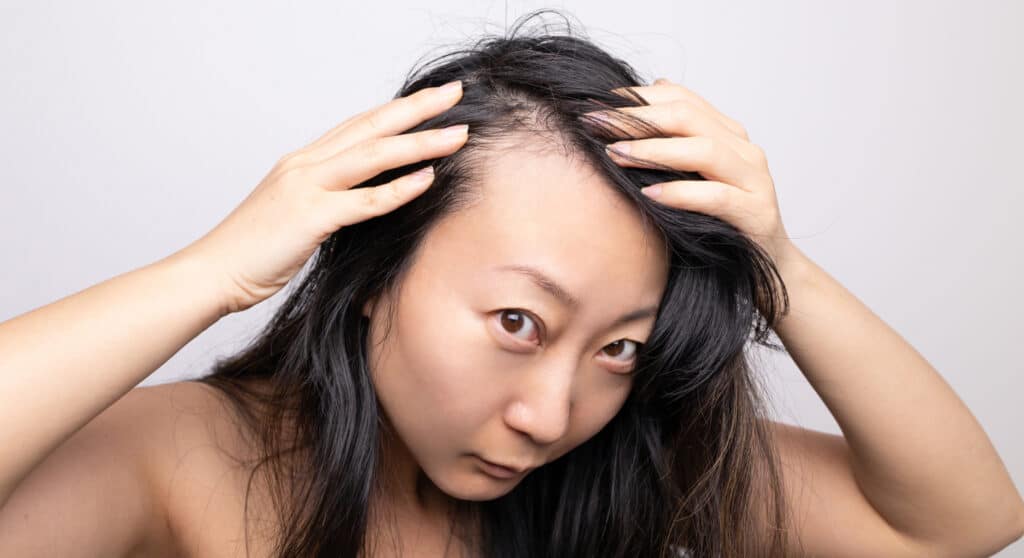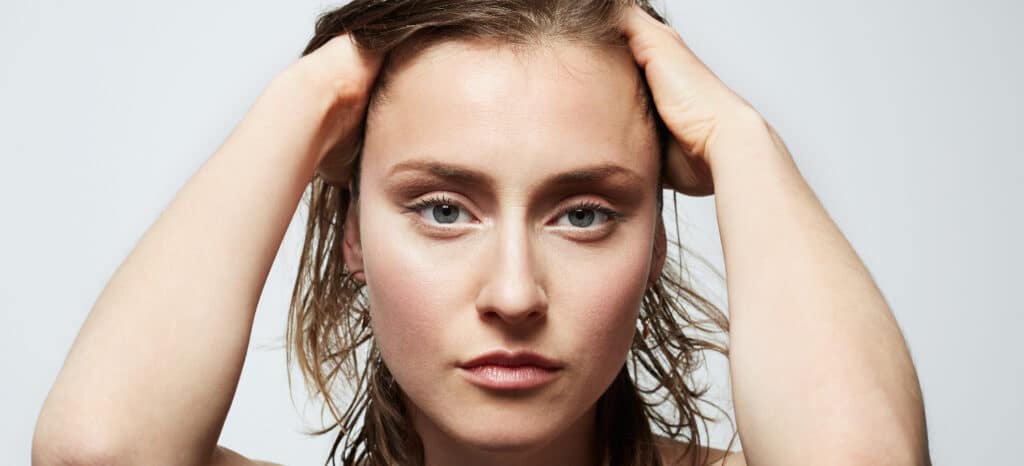If you’re facing hair loss, you’re probably checking for powerful and effective female hair loss solutions that really work. The good news is there are increasingly more options to combat hair loss in women – ranging from modern medicines, to traditional remedies, you can take your pick.
Let’s get to know more about hair loss in women before moving to remedies and treatment options available today. Ready to get started?
Female Hair Loss ~ An Introduction
When talking about hair loss in women it’s important to understand that it’s not always female pattern baldness. Though it’s one of the most common hair loss conditions that affects women, there are other possible reasons for hair loss.
Likewise, not always is it permanent hair loss, it could also be temporary hair loss in women due to various reasons including a pregnancy, giving birth, shock or stress, etc. In most cases like these, the hair loss is reversed and hair growth resumed once normalcy is restored.
Most Common Causes of Hair Loss in Women
Like mentioned earlier, women losing hair could be due to different causes. Let’s take a look at the most common causes of hair loss in women.

Stress
Stress is one of the most common causative factors for hair loss in women and men. Both emotional or physical stress can trigger temporary hair loss and that’s termed as telogen effluvium.
Hereditary Hair Loss
If one’s family experienced hair loss, it’s a possibility that it can happen again. Hereditary hair loss is common in both men and women. Androgenetic alopecia as it’s called, is a hereditary hair loss condition and can affect both men and women. Male pattern hair loss or female pattern hair loss are other terms that’s associated with androgenic alopecia. You’ve probably heard these more.
Hormonal Imbalance
Women and hormones go hand in hand. By now we’ve come to acceptance, but it is still jarring at times. It’s hard to comprehend that so many aspects are woven around hormones!
PCOS is one of the most common issues affecting women today and is due to hormonal imbalance. Even menopause related hair loss, postpartum hair loss are related to hormonal imbalance.
Hormonal upheavals have a hand in female pattern hair loss too, as does stress. Did you know hair thinning is often due to the fluctuation of estrogen and testosterone levels?
Health
Needless to say, our health is the cornerstone of our lives. Everything about us depends on our health. When we’re healthy, our hair is too!
This is probably why nutritional deficiencies and certain health conditions or medications or treatments can trigger hair loss in women and even men.
Iron deficiency is often cited as the reason behind hair loss in women. Not just iron, several other key nutrients could be the reason too! Also, certain disorders or health conditions like thyroid could cause hair loss.
Even certain treatments could be a trigger. Examples include chemotherapy, radiation, etc. Did you know birth control pills cause hair loss?
Alopecia Areata
There are different types in alopecia areata and is an autoimmune disorder that causes hair loss in women and men. While patchy hair loss is common with this hair loss condition, for women it’s less of losing hair in patches and more of hair thinning. Stress is said to be one of the major triggers for this condition.
Hair Loss Symptoms
We all lose a few strands everyday. But when it is more than the normal limit, if the hair growth isn’t as expected to replace lost hair, what happens? If we lose more than 100 strands a day, it’s termed hair loss.
What are some symptoms that can help identify when it’s hair loss? It’s best to know them so it’s like we’re missing hair by the time we take notice! This happens with women a lot because it’s not very obvious like it happens in men.
The most common symptoms are excessive shedding of hair, a receding hairline, thinning of hair particularly around one’s crown or the top of the head or even widespread thinning are most common symptoms of hair loss in women.
Herbal Remedies and Natural Solutions
The first recourse we’re going to look at natural options we women have to tackle hair loss. Herbal remedies are gaining popularity with more women resorting to natural alternatives and solutions. Let’s take a look at a few herbal remedies and natural solutions that are alternatives to hair loss treatments.
Herbs
There are many herbs to choose from when treating hair loss. Saw Palmetto, False Daisy, Indian Gooseberry, Water Hyssop, Chinese Dodder, Nettle, Horsetail, Aloe Vera, Gingko Biloba, Babchi, Fenugreek, Hibiscus, Tanner’s Cassia, Black Seed, Licorice, Coconut, etc.
Some are used in oil, some are used as masks and some can be consumed internally. The method can vary but these herbs are all helpful for hair. Depending on the herb, they help curb hair loss, prevent thinning hair, stimulate hair growth, etc.
Here are a few DIY recipes for using these herbs that might come in handy if you’re interested in going the DIY route!
DIY Fenugreek Mask
Soak 2 Tbsps. of fenugreek seeds overnight. Grind it into a thick paste adding a few spoons of coconut milk and apply as a mask for your scalp and hair. Wait for 25 minutes before washing off.
You can add Aloe Vera, Hibiscus Leaves and even Neem Leaves for this paste. I love adding False Daisy and Hibiscus Leaves along with a few Indian Gooseberries.
DIY Avocado Mask
Another one of my favorites that not only keeps hair healthy, it also leaves it shiny and soft. Chop a ripe avocado and add it to your blender. Add a spoon of Olive Oil and a few drops of Lavender Essential Oil. Blend it to a fine paste and use this as a mask. Wash off after 30 minutes for shiny and soft hair that’s also revitalized.
Essential Oils
Many essential oils help combat hair loss and improve growth. The most commonly cited and known oil is the Rosemary Oil. But that’s not all, there’s a long list of oils you can choose from to mix with carrier oils and use.
Cedarwood, Lavender, Sage, Basil, Musk, Thyme, Peppermint, Lemongrass, Tea Tree, Ylang Ylang, etc. are few essential oils that can be used. Combining these essential oils with carrier oils and using them for a stimulating scalp massage is one of my go-to choices for incorporating essential oils in my routine.
DIY Ylang Ylang Hair Serum
Add a Tbsp. of Argan Oil to a dark glass dropper bottle. To this add a few drops of Ylang Ylang Essential Oil and Rosemary Essential Oil and a drop of Thyme Essential Oil. Apply a few drops to your scalp at night and style as usual in the morning. This is very light and won’t leave your tresses oily.
Scalp Massage
Did you know scalp massage is not only a way to nourish the hair follicles, but also a way to destress? I absolutely love the massage time as my pre-shower routine. Have you tried it?
I use a blend of hair and scalp beneficial oils for the massage and do it at least once a week. I slightly warm it up and keep rotating my oils so I get more coverage.
You can also massage everyday for a few minutes slowly with your fingertips. It is a proven way to nourish your hair follicles and keep your hair and scalp healthy. It also curbs hair loss, improves shine and growth.
DIY Castor Oil Massage Blend
Add a tablespoon of cold pressed Castor Oil, to 1/4 cup of your favorite carrier oil(s). My favorites include coconut oil and sweet almond oil. Warm up the blend slightly and massage your scalp with it. Apply the rest on your hair. Wait for 25 minutes at least before washing off.
I also like to wrap my head with a warm towel after the massage and usually switch the oils every other week. I also like to use herb-infused coconut oil for this recipe. Do add your own tweaks and see how it goes!
Nutritional Supplements
There’s a reason Vitamins Revive Hair Growth Vitamins exists. Supplements are a way to naturally nourish ourselves, in return, our hair and foster a healthy environment for hair health and growth.
If deficiencies are a reason behind the hair loss or related issues, supplements are really helpful. In most cases, deficiencies are the reason, especially in women. There are blood tests that make identifying it easier. Consulting a specialist can help in this regard.
Lifestyle Changes
Our lifestyle is no longer close to nature. With the hustle and bustle of cities, hectic work and social life and pressure, stress has skyrocketed in our lives. Managing stress is really important to curb hair loss.
Want healthy hair? Say no to styling and heat or chemical treatments. This is becoming increasingly more common these days, with even children doing some sort of styling. These habits can be really damaging. Do you know some are left with permanent hair damage as a result?
Did you know scalp skin is an extension of our body skin and needs care and attention? Keeping the scalp hydrated and nourished is important to keep it problem-free.
Don’t use too many styling or hair care products that are loaded with chemicals. Choose mild and gentle products with natural ingredients, whenever possible.
Modern Treatments for Hair Loss
With advancements in the field of medicine, newer hair loss treatment options are available for women facing hair loss.
Oral & Topical Medications
Nowadays, certain oral and topical medicines are available that can help combat hair loss in women.
Minoxidil is probably widely known. It’s a topical solution that’s used to combat hair loss and improve growth in those affected due to hair loss conditions including androgenetic alopecia.
Finasteride is used to combat hair loss and improve growth. This can be used topically, or as an oral medication and usually decided by the specialist.
Spironolactone is another medicine that’s used to combat hair loss and improve growth.
Topical application of tretinoin (Retin-A) helps curb hair loss and improve growth.
Ketoconazole has been used topically to combat hair loss by reducing the production of testosterone and other androgens that trigger hair loss.
Anthralin is another topical medication that’s used to create an irritant reaction that can help stimulate our immune system and improve hair growth.
LLLT or Low Level Laser Therapy
Low level laser devices have been approved for treating female pattern hair loss or female pattern baldness. It is said to help make the most of one’s existing hair and create a natural looking hairline. Besides, there’s no risk of bruising, bleeding, infection or swelling that’s common with certain hair loss treatments.
Hair Transplant
Hair transplant or hair transplantation is a surgical procedure that involves removing hair from one area of the head and transplanting it on bald spots. This way one can have a more fuller appearance and natural looking hairline. However, the risks include infection, bleeding, swelling and bruising.
Diagnosis
While we have all this information at hand, it doesn’t mean we can all self-diagnose too! It negates the purpose of having qualified specialists, right?
While you might have an idea of what’s happening when you’re facing hair loss, there could be more than what’s visible on the surface.
Whether you’re dealing with female pattern hair loss or not, whether it’s androgenetic alopecia or not, or if it is something else altogether – identifying or diagnosing is best done by experts.
To treat female pattern baldness, male pattern baldness or other hair loss conditions there are more options than ever before. Including hair transplant, or stimulating hair regrowth and growth, curbing hair shedding and what not – the options are now many, but the diagnosis and choosing the right treatment option or plan should be done by experts.
How to Choose the Right Treatment Option?

Choosing a treatment depends on many factors including one’s personal preference, schedule, expectations and more. Consulting a specialist and working with them to come up with the right treatment protocol helps. However, for some it might take more time than others, or involve trials and errors. Be patient and stay strong – we can beat it!
Conclusion
We’ve discussed the issue of hair shedding in women and possible causes and symptoms to identify the issue. However, to treat hair loss, the first step is to understand what’s happening and dealing with it. Hair falls for everyone, accepting that is the first step towards healing.
With the right efforts, we can minimize hair loss and hair breakage and improve hair growth. The key is working with your physician and specialist to come up with a hair care plan that works best for you and go from there.
Like we always say, it’s not wrong to try natural remedies. In fact it’s a great idea, but when it doesn’t yield results, or if your problem increases or persists, it’s time to consult a specialist. What do you say?

